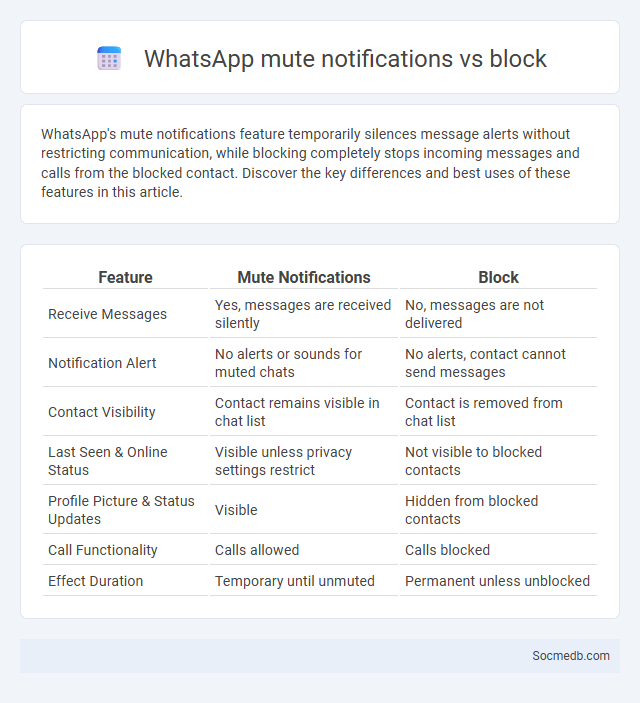
Photo illustration: WhatsApp mute notifications vs block
WhatsApp's mute notifications feature temporarily silences message alerts without restricting communication, while blocking completely stops incoming messages and calls from the blocked contact. Discover the key differences and best uses of these features in this article.
Table of Comparison
| Feature | Mute Notifications | Block |
|---|---|---|
| Receive Messages | Yes, messages are received silently | No, messages are not delivered |
| Notification Alert | No alerts or sounds for muted chats | No alerts, contact cannot send messages |
| Contact Visibility | Contact remains visible in chat list | Contact is removed from chat list |
| Last Seen & Online Status | Visible unless privacy settings restrict | Not visible to blocked contacts |
| Profile Picture & Status Updates | Visible | Hidden from blocked contacts |
| Call Functionality | Calls allowed | Calls blocked |
| Effect Duration | Temporary until unmuted | Permanent unless unblocked |
Understanding WhatsApp Notifications: A Brief Overview
WhatsApp notifications deliver real-time alerts for message receipts, group activity, and calls, enabling instantaneous user engagement. Customizable notification settings allow users to tailor sound alerts, vibration patterns, and popup messages to enhance communication efficiency. Understanding notification categories such as message previews, muted chats, and status updates is crucial for managing information flow on this widely used messaging platform.
What Does ‘Mute Notifications’ Mean on WhatsApp?
Mute Notifications on WhatsApp allows you to silence message alerts from specific chats or groups without blocking or leaving them, ensuring peace without missing important conversations. This feature helps you control your notification overload by customizing alert settings for individual contacts, making your social media experience less distracting and more manageable. Use Mute Notifications to maintain focus while still staying connected to your network.
How Does ‘Block’ Differ from Muting on WhatsApp?
Blocking on WhatsApp prevents the blocked contact from sending messages, viewing your last seen, status updates, and profile photo, ensuring complete privacy from that user. Muting, however, only silences notifications from the contact or group without restricting their ability to send messages or view your activity status. Your choice between blocking and muting depends on whether you want to stop all communication and visibility or simply reduce notification disruptions.
Key Differences: WhatsApp Mute Notifications vs Block
WhatsApp mute notifications allow users to silence alerts from specific chats or groups without restricting message delivery, preserving communication while reducing interruptions. In contrast, blocking a contact prevents all messages, calls, and status updates from that person, effectively cutting off interaction and visibility. This distinction is crucial for managing privacy and communication preferences on the platform.
When Should You Use WhatsApp Mute Notifications?
Using WhatsApp mute notifications is ideal during meetings, focused work sessions, or while sleeping to prevent distractions while maintaining access to important messages. Muting group chats with high activity but low relevance helps reduce notification overload without missing critical updates. This feature supports maintaining productivity and mental well-being by managing communication flow effectively.
Scenarios to Consider Blocking vs Muting Contacts
When managing your social media interactions, consider blocking contacts who consistently share harmful content, violate your privacy, or engage in harassment to protect your mental well-being. Muting contacts can be effective when you want to avoid seeing their posts without severing the connection, maintaining a level of privacy and control over your feed. You can tailor your social media experience by evaluating the impact of contacts on your digital environment and choosing the appropriate action accordingly.
Privacy Implications: Muting vs Blocking on WhatsApp
Muting on WhatsApp allows users to silence notifications from specific contacts or groups without restricting message delivery, maintaining privacy by preventing unwanted alerts while preserving the connection. Blocking, however, enforces stricter privacy controls by preventing the blocked user from sending messages, viewing status updates, or seeing profile changes, effectively cutting off communication and visibility. Understanding these distinctions helps users tailor their privacy settings to balance discretion and social engagement on WhatsApp.
Effects on Chat Visibility: Mute Notifications vs Block
Muting notifications on social media hides chat alerts without removing the conversation from the chat list, maintaining visibility while reducing distractions. Blocking a user removes the chat entirely, preventing message delivery and eliminating all interaction visibility from both parties. The choice between muting and blocking directly impacts user experience by controlling notification flow and chat accessibility on platforms like Facebook Messenger and WhatsApp.
How to Mute Notifications and Block Contacts on WhatsApp
To mute notifications on WhatsApp, open the chat, tap the contact or group name at the top, select "Mute notifications," and choose the desired duration (8 hours, 1 week, or Always). Blocking contacts involves going to Settings > Privacy > Blocked Contacts > Add New, then selecting the contact to block messages and calls from that user. These features help manage communication by reducing distractions and preventing unwanted interactions on the platform.
Choosing the Right Option: Mute Notifications or Block?
Choosing between muting notifications and blocking on social media depends on the desired level of interaction control and privacy. Muting notifications allows users to silence updates from specific accounts without severing connections, preserving the ability to engage when preferred. Blocking completely restricts contact and visibility, offering a more definitive way to protect personal boundaries from unwanted interactions.
 socmedb.com
socmedb.com